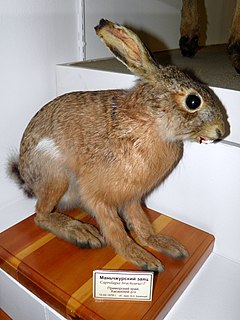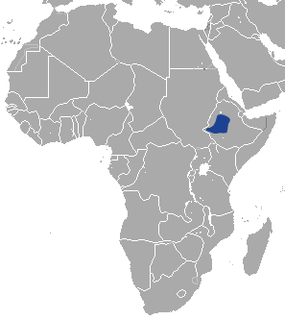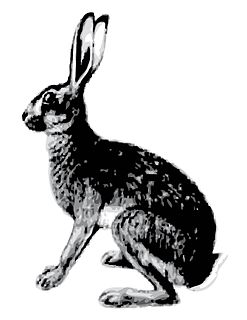
Hares and jackrabbits are leporids belonging to the genus Lepus. Hares are classified in the same family as rabbits. They are similar in size and form to rabbits and have similar herbivorous diets, but generally have longer ears and live solitarily or in pairs. Also unlike rabbits, their young are able to fend for themselves shortly after birth rather than emerging blind and helpless. Most are fast runners. Hare species are native to Africa, Eurasia and North America.

Leporidae is the family of rabbits and hares, containing over 60 species of extant mammals in all. The Latin word Leporidae means "those that resemble lepus" (hare). Together with the pikas, the Leporidae constitute the mammalian order Lagomorpha. Leporidae differ from pikas in that they have short, furry tails and elongated ears and hind legs.

The Arctic hare is a species of hare which is highly adapted to living in the Arctic tundra, and other icy biomes. The Arctic hare survives with shortened ears and limbs, a small nose, fat that makes up 20% of its body, and a thick coat of fur. It usually digs holes in the ground or under snow to keep warm and to sleep. Arctic hares look like rabbits but have shorter ears, are taller when standing and, unlike rabbits, can thrive in extreme cold. They can travel together with many other hares, sometimes huddling with dozens or more, but are usually found alone, sometimes taking more than one partner. The Arctic hare can run up to 60 kilometres per hour (40 mph).

The European hare, also known as the brown hare, is a species of hare native to Europe and parts of Asia. It is among the largest hare species and is adapted to temperate, open country. Hares are herbivorous and feed mainly on grasses and herbs, supplementing these with twigs, buds, bark and field crops, particularly in winter. Their natural predators include large birds of prey, canids and felids. They rely on high-speed endurance running to escape predation, having long, powerful limbs and large nostrils.

The Cape hare, also called the desert hare, is a hare native to Africa and Arabia extending into India.

The antelope jackrabbit, found in Southern Arizona and Northwestern Mexico, is a species of North American hare. Within this range, it occupies dry desert areas. This species is placed in family Leporidae, which is within order Lagomorpha. Male and female antelope jackrabbits are identical in appearance. This species is large in size with long, pointed ears and a distinct coat coloration. The antelope jackrabbit has a white belly, light grey sides, a back peppered with black, and orange coloration on the neck and chest. It is similar to species like the black-tailed jackrabbit and white-sided jackrabbit. It is most active during twilight (crepuscular) and during the night (nocturnal), but can be active during the day when conditions are favorable. It feeds on cacti, mesquite leaves, and other vegetation.

The Indian hare, also known as the black-naped hare, is a common species of hare found in the Indian Subcontinent and in Java. Introduced to Madagascar, Comoro Islands, Andaman Islands, Irian Jaya, Papua New Guinea, Seychelles, Mayotte, Mauritius and Réunion

The Manchurian hare is a species of hare found in northeastern China and Russia, the Amur River basin, and the higher mountains of northern Korea. It lives in forests and the IUCN has assessed its conservation status as being of "least concern".

The scrub hare is one of two subspecies of hares found in southern Namibia, Mozambique, South Africa, Swaziland and Lesotho. Although it is listed as a least critical species, the population has been declining and is expected to decline by 20% until the year 2104. The species is endemic to southern Africa and has not been seen in any other geographic locations around the world.

The Ethiopian hare is a species of mammal in the family Leporidae. It was first described in 1903, by the British mammalogist Oldfield Thomas. The dorsal pelage is brownish buff, and is finely grizzled with black. The ventral pelage is fluffy and white in colour. Endemic to Africa, it is found in the Afromontane Biozone of Ethiopia, and in the borders of the Sudanian Savanna Biozone. It is rated as a least concern species by the International Union for Conservation of Nature.

The Abyssinian hare is a species of mammal in the family Leporidae. It is almost entirely restricted to the nations of the Horn of Africa, though it extends marginally into eastern Sudan and may also occur in far northern Kenya. It has been suggested it should be considered conspecific with the Cape hare, but is considered a separate species based on (presumed) sympatry in their distributions.

The African savanna hare is a mammal species in the family Leporidae, native to Africa. It is native to diverse regions and habitats of Africa, including savannas and the Sahel. It is found in: Algeria, Botswana, Burundi, Chad, the Democratic Republic of the Congo, Côte d'Ivoire, Ethiopia, the Gambia, Ghana, Guinea, Guinea-Bissau, Kenya, Libya, Mali, Mauritania, Morocco, Mozambique, Namibia, Niger, Rwanda, Senegal, Sierra Leone, Somalia, South Africa, Sudan, Tanzania, Tunisia, Uganda, and Zambia. It is listed as "least concern" on the IUCN Red List.

The Ethiopian highland hare is a medium-sized species of mammal in the rabbit and hare family, Leporidae. Its dorsal pelage is grizzled, buff white and spotted and streaked with black, while its belly fur is pure white and fluffy. It is endemic to the Ethiopian Highlands, ranging over the Afroalpine regions of the Shoa, Bale, and Arsi Provinces of Ethiopia. A herbivore, it mostly feeds on moorland grasses. The IUCN rates it as a species of least concern.

The Yarkand hare is a species of mammal in the family Leporidae. It has soft, straight, sandy brown dorsal pelage which has grayish-black stripes, and completely white ventral pelage. Endemic to China, the Yarkand hare is restricted to the Tarim Basin in Southern Xinjiang, China. It is mainly nocturnal, and forages on grass and crops. The female produces two or three litters annually, each consisting of two to five young. It is rated as near threatened on the International Union for Conservation of Nature Red List of Endangered Species and by the Red List of China's Vertebrates. However, Chinese geneticists have stated the species is "endangered" due to limited habitat and its fragmentation, and over-hunting and poaching.

The black-tailed jackrabbit, also known as the American desert hare, is a common hare of the western United States and Mexico, where it is found at elevations from sea level up to 10,000 ft (3,000 m). Reaching a length around 2 ft (61 cm), and a weight from 3 to 6 lb, the black-tailed jackrabbit is the one of the largest North American hares. Black-tailed jackrabbits occupy mixed shrub-grassland terrains. Their breeding depends on the location; it typically peaks in spring, but may continue all year round in warm climates. Young are born fully furred with eyes open; they are well camouflaged and are mobile within minutes of birth, thus females do not protect or even stay with the young except during nursing. The average litter size is around four, but may be as low as two and as high as seven in warm regions.

The ancient Egyptian Hare hieroglyph, Gardiner sign listed no. E34 (𓃹) is a portrayal of the desert hare of Egypt, within the Gardiner signs for mammals. The ancients used the name of sekhat for the hare.

The desert hare is a species of hare found in Northwest China and countries adjacent to it. Little is known about this species except that it inhabits grassland and scrub areas of desert and semi-desert. The International Union for Conservation of Nature has assessed its conservation status as being of "least concern."

The Corsican hare, also known as the Apennine hare or Italian hare, is a species of hare found in southern and central Italy and Corsica.
















